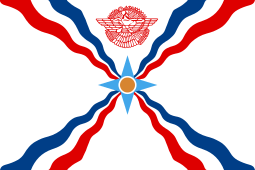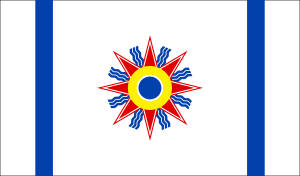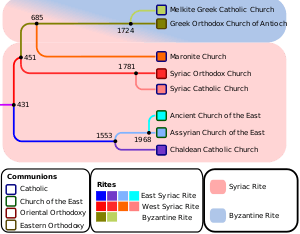Assyrian–Chaldean–Syriac diaspora
The Assyrian diaspora (Syriac: ܓܠܘܬܐ, Galuta, "exile") refers to Assyrians living in communities outside their ancestral homeland. The Eastern Aramaic-speaking Assyrians are descendants of the ancient Assyrians, and are one of the few ancient Semitic ethnicities in the Near East who resisted Arabisation, Turkification and Islamisation during and after the Arab conquest of Iraq, Syria, Turkey and Iran.
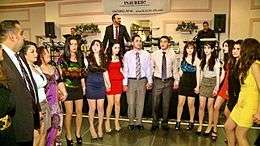
The indigenous Assyrian homeland is within the borders of northern Iraq, southeastern Turkey, northwestern Iran, and more recently, northeastern Syria, a region roughly corresponding with Assyria from the 25th century BC to the seventh century AD.[1] Assyrians are predominantly Christians; most are members of the Assyrian Church of the East, the Ancient Church of the East, the Chaldean Catholic Church, the Syriac Orthodox Church, the Assyrian Pentecostal Church or the Assyrian Evangelical Church. The terms "Syriac", "Chaldean" and "Chaldo-Assyrian" can be used to describe ethnic Assyrians by their religious affiliation, and indeed the terms "Syriac" and "Syrian" are much later derivatives of the original "Assyrian", and historically, geographically and ethnically originally meant Assyrian (see Etymology of Syria).
Before the Assyrian genocide, the Assyrian people were largely unmoved from their native lands which they had occupied for about 5,000 years. Although a handful of Assyrians had migrated to the United Kingdom during the Victorian era, the Assyrian diaspora began in earnest during World War I (1914-1918) as the Ottoman Empire conducted both large scale genocide and ethnic cleansing against the Assyrian people with the aid of local Kurdish, Iranian and Arab tribes. This genocide was coordinated alongside the Armenian genocide, Greek genocide and Great Famine of Mount Lebanon.
Further atrocities such as the Simele Massacres of the 1930s also stimulated migration.
Additional emigration occurred in the 1980s, as Assyrian communities fled the violence of the Kurdish–Turkish conflict and the establishment of the Islamic Republic of Iran. During the 1990s and 2000s, Assyrians left the Middle East to evade persecution in Ba'athist Iraq and from Sunni and Shia fundamentalists. The exodus continues, as Assyrians flee Iraq and northeast Syria due to genocide by the Islamic State of Iraq and the Levant and other Sunni Islamist groups.[2]
Demographic estimates
| Country (or region) | Most-recent census | Assyrian-Chaldean-Syriac population (2008) |
Total country (or region) population (2008)[3] |
% Assyrian | Further information |
|---|---|---|---|---|---|
| Iraq | - | 500,000[4][5]-1,500,000[6] | 30,711,152 | 2%-5% | Assyrians in Iraq |
| Syria | - | 30,000[7]-200,000[8] | 20,581,290 | 0.1%-1% | Assyrians in Syria |
| United States | 82,355 (2000)[9] | 100,000[10]-500,000[6][11] | 307,006,550 | 0.03%-0.17% | Assyrian Americans |
| Sweden | - | 100,000[12]-120,000[6] | 9,219,637 | 1.2% | Assyrians in Sweden |
| Jordan | - | 44,000[6]-150,000[13][14] | 5,906,043 | 0.7% | Assyrians in Jordan |
| Germany | - | 70,000[15]-100,000[6] | 82,110,097 | 0.12% | German Assyrians |
| Iran | - | 74,000[11]-80,000[16] | 71,956,322 | 0.11% | Assyrians in Iran |
| Lebanon | - | 37,000[17]-100,000[6] | 4,193,758 | 0.9%-2.38% | Assyrians in Lebanon |
| Turkey | - | 24,000[11]-70,000[18] | 73,914,260 | 0.03%-0.1% | Assyrians in Turkey |
| Russia | 13,649 (2002)[19] | 70,000[6] | 141,950,000 | 0.05% | Assyrians in Russia |
| Australia | 46,217 (2016)[20] | 23,431,800 | 0.13% | Assyrian Australians | |
| Canada | 8,650 (2006)[21] | 38,000[22] | 33,311,400 | 0,11% | Assyrians in Canada |
| Netherlands | - | 20,000[6] | 16,445,593 | 0.12% | Assyrians in the Netherlands |
| France | - | 40,000[6] | 62,277,432 | 0.06% | Assyrians in France |
| Belgium | - | 15,000[6] | 10,708,433 | 0.14% | |
| Georgia | 3,299 (2002)[23] | 15,000[6] | 4,385,400 | 0.34% | Assyrians in Georgia |
| Armenia | 2,769 (2011)[24] | 15,000[6] | 3,018,854 | 0.09% | Assyrians in Armenia |
| Brazil | - | 10,000[6] | 193,733,795 | 0.005% | |
| Switzerland | - | 10,000[6] | 7,647,675 | 0.13% | |
| Denmark | - | 10,000[6] | 5,493,621 | 0.18% | |
| Greece | - | 8,000[6] | 11,237,094 | 0.07% | Assyrians in Greece |
| Great Britain | - | 8,000[6] | 51,446,000 | 0.02% | British Assyrians |
| Austria | - | 7,000[6] | 8,336,926 | 0.08% | |
| Italy | - | 3,000[6] | 59,832,179 | 0.005% | |
| Azerbaijan | - | 1,400[6] | |||
| New Zealand | 1,683 (2006)[25] | 3,000[6] | 4,268,900 | 0.07% | |
| Mexico | - | 2,000[6] | 106,350,434 | 0.002% | |
| Other | - | 100,000[6] | |||
| Total | - | 3.3 million[26]-4.2 million[27] |
Russia
From 1937 to 1959, the Assyrian population in the USSR grew by 587.3 percent.[28]
Former Soviet Union
History
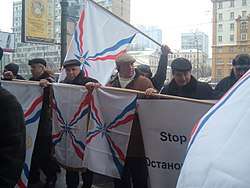
Assyrians came to Russia and the Soviet Union in three large waves. The first wave was after the Treaty of Turkmenchay in 1828, that delineated a border between Russia and Persia. The second was as a result of the Assyrian genocide during and after World War I; the third was after World War II, when the Soviet Union unsuccessfully tried to establish a satellite state in Iran. Soviet troops withdrew in 1946, and left the Assyrians (who supported the coup) exposed to retaliation identical to that received from the Turks 30 years earlier. Soviet authorities persecuted Assyrian religious and community leaders in the same way that they persecuted Russians who remained members of the Russian Orthodox Church.
Although Assyrians tended to assimilate into the Armenian community in the Soviet Union, their cultural identity found new expression under glasnost. Most Assyrians are members of the Assyrian Church of the East; other churches include the Syriac Orthodox Church and the Chaldean Catholic Church.[29]
USSR census
- 1897 census: 5,300 "Assyrians" (by language)[30]
- 1919 refugee status:
Russian census
- 1989 census: 9,600 Assyrians, of whom 4,742 spoke the Syriac language; 1,738 in the Krasnodar region[29]
- 2002 census: 13,649 Assyrians (ассирийцы)[19]
Armenia
Georgia
Ukraine
- 2001 census: 3,143[38]
Lebanon
| Denomination | Beyrouth | Mount Lebanon | North Lebanon | South Lebanon | Biqa' | Total |
|---|---|---|---|---|---|---|
| Syriac Catholics | 4,089 | 275 | 169 | 9 | 442 | 4,984 |
| Syriac Orthodox | 2,070 | 209 | 100 | 22 | 1,352 | 3,753 |
| Chaldean Catholic | 974 | 120 | 1 | 10 | 225 | 1,330[40] |
| Denomination | 1932 census[41] | 1944 estimates[40] | 1954 estimates[41] |
|---|---|---|---|
| Syriac Catholics | 2,675 | 4,984 | – |
| Chaldean Catholics | 528 | 1,330 | – |
| Syriac Orthodox | 2,574 | 3,753 | 4,200 |
| Church Of The East | 800 | 1,200 | 1,400 |
The Americas
United States
- 1990 census: 46,099 Assyrians[44]
- 19,066 born in the U.S.
- 16,783 arrived before 1980.
- 10,250 from 1980 to 1990
- 27,494 listed Syriac as the "Language Spoken at Home"[45]
- Unemployment: 9.1 Percent
- 2000 census: 82,355 Assyrians/Chaldeans/Syrians[46]
- 34,484 in Michigan:[47]
- Sterling Heights: 5,515 (4.4 percent of the city)
- West Bloomfield: 4,874 (7.5 percent)
- Southfield: 3,684 (4.7 percent)
- Warren: 2,625 (1.9 percent)
- Farmington Hills 2,499 (3 percent)
- Troy: 2,047 (2.5 percent)
- Detroit, Michigan 1,963 (0.2 percent)
- Oak Park 1,864 (6.3 percent)
- Madison Heights: 1,428 (4.6 percent)
- Orchard Lake Village: 241 (10.9 percent)
- 22,671 in California:[48]
- 15,685 in Illinois[49]
- Chicago: 7,121 (0.2 percent)
- Niles, Illinois: 3,410 (3.3 percent)
- Maine Park: 1,035 (0.8 percent)
- Syriac speakers: 46,932[50]
- 34,484 in Michigan:[47]
Uruguay
- According to the Joshua Project, there are about 3,000 Assyrians in Uruguay.[51]
Argentina
Next to Uruguay, in Argentina the Syriac Orthodox Church counts with a Patriarchal Vicar.[52] However, the actual number of Syriacs is hard to know because the Argentine Census does not ask for ethnicity. Furthermore, their assimilation rate is very high, as it happens with other Middle-Estern communities settled in the country. There is Syriac presence in Buenos Aires, La Plata, Córdoba, Salta and Frías.[53][54] In the past, intellectuals like Farid Nazha went into exile in Argentina. Although 2,000 Syriacs are listed in Argentina, the actual number may be higher.[55]
Europe
Belgium
Assyrians arrived in Belgium primarily as refugees from the Turkish towns of Midyat and Mardin in Tur Abdin. Most belong to the Syriac Orthodox Church, but some belong to the Assyrian Church of the East and the Chaldean Catholic Church. Their three main settlements are in the Brussels municipalities of Saint-Josse-ten-Noode (where their municipal councilman, Christian Democrat Ibrahim Erkan, is originally from Turkey) and Etterbeek, Liège and Mechelen. Two more councilmen were elected in Etterbeek on October 8, 2006: the Liberal Sandrine Es (whose family is from Turkey) and the Christian Democrat Ibrahim Hanna (from Syria's Khabur region). Flemish author August Thiry wrote Mechelen aan de Tigris (Mechelen on the Tigris) about Assyrian refugees from Hassana in the southeastern Turkish district of Silopi; municipal candidate Melikan Kucam is one of them. In the October 14, 2012 municipal elections, Kucam was elected in Mechelen as a member of the Flemisch nationalists N-VA.
France
An estimated 20,000 Assyrians live in France, primarily concentrated in the northern French suburbs of Sarcelles (where several thousand Chaldean Catholics live) and in Gonesse and Villiers-le-Bel. They are from several villages in south-eastern Turkey.[56][57]
Germany
The number of Assyrians in Germany is estimated at about 100,000.[58] Most Assyrian immigrants and their descendants in Germany live in Munich, Wiesbaden, Paderborn, Essen, Bietigheim-Bissingen, Ahlen, Göppingen, Köln, Hamburg, Berlin, Augsburg and Gütersloh.
Since they were persecuted throughout the 20th century for their religion, many Assyrians arrived from Turkey seeking a better life. The first large wave arrived during the 1960s and 1970s as part of the gastarbeiter (guest worker) economic program. Germany was seeking immigrant workers (largely from Turkey) and many Assyrians, seeing opportunities for freedom and success, applied for visas. Assyrians began working in restaurants or in construction, and many began operating their own shops. The first Assyrian immigrants in Germany organized by forming culture clubs and building churches. The second wave came in the 1980s and 1990s as refugees from the Turkish-PKK conflict in the Turkish Kurdistan region.
Greece
The first Assyrian migrants arrived in Greece in 1934, and settled in Makronisos (today uninhabited), Keratsini, Pireus, Egaleo and Kalamata.[59] The vast majority of Assyrians (about 2,000) live in Peristeri, a suburb of Athens.[60] There are five Assyrian Christian marriages recorded at St. Paul's Anglican Church in Athens in 1924–25 (the transcripts can be viewed on St. Paul's Anglican Church website), indicating the arrival of refugees at that time.
Netherlands
The first Assyrians came to the Netherlands in the 1970s, primarily from Turkey and observing the West Syriac Rite. The number of Assyrians in the country is currently estimated at 25,000 to 35,000. They primarily live in the eastern Netherlands, in Enschede, Hengelo, Almelo and Borne in the province of Overijssel.
Sweden
In the late 1970s, about 12,000 Assyrians from Turkey, Iran, Iraq and Syria emigrated to Sweden. Although they considered themselves persecuted for religious and ethnic reasons, they were not recognized as refugees. Those who had lived in Sweden for a longer period received residence permits for humanitarian reasons.[61]
Södertälje is considered the unofficial Assyrian capital of Europe because of the city's high percentage of Assyrians. The Assyrian TV channels Suryoyo Sat and Suroyo TV are based in Södertälje. From 2005 to 2006 and since 2014, the Assyrian Ibrahim Baylan has been a minister in the Swedish government.
Switzerland
Assyrians arrived in Switzerland primarily as refugees from the towns of Midyat, Mardin and Beth-Zabday (Idil) in Tur Abdin. Most (about 1,600 families) are Syriac Orthodox. The seat of the Syriac Orthodox bishop of the Swiss and Austrian diocese is in the St. Avgin (Eugene) Monastery in Arth, near Lucerne, where a large portion of the Assyrian community lives. Assyrians also live in eastern canton of St. Gallen (in the Wil area) and in Baden, about 20 km from Zurich. Many Assyrians also live in the Italian-speaking canton of Ticino, primarily in Lugano and Locarno.
United Kingdom
About 8,000 Assyrians live in the United Kingdom, primarily in London and Manchester. Although the first Assyrians arrived during the 1850s, most immigration began in the 1950s.[56]
Pacific
Australia
According to the 2016 census, 46,217 people identified themselves as having Assyrian or Chaldean ancestry (0.13 percent of Australia's population).[62] Of the Assyrians in Australia, 21,000 are members of the Assyrian Church of the East and 9,000 are members of the Chaldean Catholic Church. The City of Fairfield, in Sydney, has the country's largest number of Assyrians.[63] In Sydney, Assyrians are the leading ethnic group in the Fairfield LGA suburbs of Fairfield, Fairfield Heights and Greenfield Park. In Melbourne, Assyrians live in the northwestern suburbs of Broadmeadows, Craigieburn, Meadow Heights, Roxburgh Park and Fawkner. In 2011, Melbourne had 8,057 people who claimed Assyrian ancestry.[64]
New Zealand
- 1991 census: 315[65]
- 1996 census: 807[65]
- 2001 census: 1,176[65]
- 465 in the Auckland region
- 690 in the Wellington region
- Highest unemployment rate (40 percent)
- Highest-percentage-Christian ethnic group (99 percent)
- English spoken: 774; no English: 348. Number of languages spoken: 1: 225; 2: 405; 3: 423; 4: 63; 5: 3
- 2006 census: 1,683[25]
Homeland statistics
The United Nations High Commissioner for Refugees (UNHCR) reported in October 2005 that of the 700,000 Iraqis who took refuge in Syria between October 2003 and March 2005, 36 percent were "Iraqi Christians".
See also
References
- "The Chaldean Assyrian Syriac People of Iraq: An Ethnic Identity Problem – Shak Hanish - The American Foundation for Syriac Studies".
- Jacobson, Rodolfo (2001). Codeswitching Worldwide II. Walter de Gruyter. p. 159. ISBN 978-3-11-016768-9.
- CIA-The World Factbook. "Country Comparison:Population". Archived from the original on 28 October 2009. Retrieved 2009-10-27.
- "The World Factbook". CIA World Factbook.
- Pike, John. "Christians in Iraq". Retrieved 13 March 2017.
- Brief History of Assyrians, AINA.org
- https://english.enabbaladi.net/archives/2018/04/assyrians-in-syria-an-ethnic-minority-group-resisting-war/
- https://www.assyrianpolicy.org/syria
- 2000 Census USA Archived February 10, 2020, at Archive.today
- Bureau, U.S. Census. "U.S. Census website". Retrieved 13 March 2017.
- atour.com
- Demographics of Sweden, Swedish Language Council "Sweden has also one of the largest exile communities of Assyrian and Syriac Christians (also known as Chaldeans) with a population of around 100,000."
- Thrown to the Lions Archived 2013-08-08 at the Wayback Machine, Doug Bandow, The America Spectator
- Jordan Should Legally Recognize Displaced Iraqis As Refugees, AINA.org. Assyrian and Chaldean Christians Flee Iraq to Neighboring Jordan, ASSIST News Service
- 70,000 Syriac Christians according to REMID (of which 55,000 Syriac Orthodox).
- Archived 2012-02-04 at the Wayback Machine, SIL Ethnologue "Assyrian Neo-Aramaic 15,000 in Iran (1994). Ethnic population: 80,000 (1994)" See also Christianity in Iran.
- Languages of Lebanon, Ethnologue "Immigrant languages: Assyrian Neo-Aramaic (1,000), Chaldean Neo-Aramaic (18,000), Turoyo (18,000)."
- , SIL Ethnologue "Turoyo [tru] 3,000 in Turkey (1994 Hezy Mutzafi). Ethnic population: 50,000 to 70,000 (1994). Hértevin [hrt] 1,000 (1999 H. Mutzafi). Originally Siirt Province. They have left their villages, most emigrating to the West, but some may still be in Turkey." See also Christianity in Turkey.
- "2002 census" (PDF). Archived from the original (PDF) on 2012-02-04. Retrieved 2006-02-17.
- "CULTURAL DIVERSITY IN AUSTRALIA, 2016". Australian Bureau of Statistics. 27 June 2017. Archived from the original on 9 July 2017. Retrieved 27 June 2017.
- "Ethnic Origin (247), Single and Multiple Ethnic Origin Responses (3) and Sex (3) for the Population of Canada,". Statistics Canada. 2006. Retrieved 2010-06-17.
- "Archived copy". Archived from the original on 2012-03-11. Retrieved 2012-01-28.CS1 maint: archived copy as title (link)
- "Eurominority – La solidarité avec le peuple palestinien". Archived from the original on 19 December 2007. Retrieved 13 March 2017.
- 2011 Armenian Census - De Jure Population (Urban, Rural) by Age and Ethnicity
- "Home". Retrieved 13 March 2017.
- , UNPO estimates
- SIL Ethnologue estimate for the "ethnic population" associated with Assyrian Neo-Aramaic.
- Mastyugina, Tatiana; Perepelkin, Lev; Naumkin, Vitaliĭ Vi︠a︡cheslavovich; Zvi︠a︡gelʹskai︠a︡, Irina Donovna (1996). An Ethnic History of Russia Pre-revolutionary Times to the Present. Greenwood Publishing Group. p. 83. ISBN 978-0-313-29315-3.
- Assyrians Archived September 30, 2007, at the Wayback Machine, Center for Russian Studies, NUPI - Norwegian Institute of International Affairs Archived 2006-02-10 at the Wayback Machine
- Youri Bromlei et al., Processus ethniques en U.R.S.S., Editions du Progrès, 1977
- Eden Naby, "Les Assyriens d'Union soviétique," Cahiers du Monde russe, 16/3-4. 1975
- A. Chatelet (Supérieur de la mission catholique de Téhéran), Question assyro-chaldéenne, Quartier général - Bureau de la Marine, Constantinople, 31 août 1919
- An Ethnohistorical Dictionary of the Russian and Soviet Empires, by James Stuart Olson, Lee Brigance Pappas, Nicholas Charles
- Eden Naby 1975
- Annuaire démographique des Nations-Unies 1983, Département des affaires économiques et sociales internationales, New York, 1985
- "Armenian Helsinki Committee - Reflections over Annual Report on International Religious Freedom: Armenia". Archived from the original on 2007-02-13. Retrieved 2006-02-07.
- 2001 Armenian Census - De Jure Population (Urban, Rural) by Age and Ethnicity
- "All-Ukraine population census 2001". Archived from the original on 2007-09-30. Retrieved 2006-04-05.
- Assyrian cultural center in Kazakhstan
- Albert H. Hourani, Minorities in the Arab World, London: Oxford University Press, 1947
- Kenneth C. Bruss, "Lebanon - Area and population," Encyclopædia Britannica, 1963
- Canada, Government of Canada, Statistics. "Statistics Canada: Ethnocultural Portrait of Canada Highlight Tables, 2006 Census". Retrieved 13 March 2017.
- Canada, Government of Canada, Statistics. "2011 National Household Survey: Data tables – Ethnic Origin (264), Single and Multiple Ethnic Origin Responses (3), Generation Status (4), Age Groups (10) and Sex (3) for the Population in Private Households of Canada, Provinces, Territories, Census Metropolitan Areas and Census Agglomerations, 2011 National Household Survey". Retrieved 13 March 2017.
- U.S. Bureau of the Census - Selected Characteristics for Persons of Assyrian Ancestry: 1990
- U.S. Bureau of the Census, Language Spoken at Home for the Foreign-Born Population 5 Years and Over: 1980 and 1990, Internet Release date: March 9, 1999
- US Census, QT-P13. Ancestry: 2000 Archived February 10, 2020, at Archive.today
- "2000 Michigan Census". Archived from the original on February 12, 2020. Retrieved November 18, 2017.CS1 maint: BOT: original-url status unknown (link)
- "2000 California Census". Archived from the original on February 12, 2020. Retrieved November 18, 2017.CS1 maint: BOT: original-url status unknown (link)
- "2000 Illinois Census". Archived from the original on February 10, 2020. Retrieved November 18, 2017.CS1 maint: BOT: original-url status unknown (link)
- U.S. Census 2000, Language Spoken at Home for the Foreign-Born Population 5 Years and Over: 1980 to 2000
- Project, Joshua. "Assyrian in Uruguay". joshuaproject.net.
- "Directories - World".
- "Argentina recibe al Patriarca de la Iglesia Siriana Ortodoxa".
- "El líder de la Iglesia Siriano Ortodoxa de Antioquía llega a Argentina e inaugurará un monumento en La Plata".
- "Assyria, the Province of Nineveh (Mosul) and the League of Nations".
- "Brief History of Assyrians". Retrieved 13 March 2017.
- Gaunt, David, "Cultural diversity, Multilingualism and Ethnic minorities in Sweden - Identity conflicts among Oriental Christian in Sweden", s.10.
- "Diskussion zum Thema 'Aaramäische Christen' im Kapitelshaus" Borkener Zeitung (in German) (archived link, 8 October 2011)
- ZINDA. "ZENDA - May 10, 1999". Archived from the original on 28 August 2003. Retrieved 13 March 2017.
- "Greece". Retrieved 13 March 2017.
- Swedish Minister for Development Co-operation, Migration and Asylum Policy, Migration 2002, June 2002 Archived September 26, 2006, at the Wayback Machine
- Kinarah: Twentieth Anniversary of Assyrian Australian Association 1989, Assyrian Australian Association, Edensor Park.
- Community Relations Commission For a Multicultural NSW 2004, Cultural Harmony. The Next Decade 2002-2012 (White Paper), New South Wales Government, Sydney South.
- Stone, W. 2001, Measuring Social Capital: Towards a theoretically informed measurement framework for researching social capital in family and community life, Research Paper No. 24, February, Australian Institute of Family Studies, Melbourne.
- "Statistics New Zealand - 2001 Census of Population and Dwellings - Ethnic Groups" (PDF).
Bibliography
- Eden Naby, "Les Assyriens d'Union soviétique," Cahiers du Monde russe, 16/3-4. 1975
- Eden Naby, The Iranian Frontier Nationalities: The Kurds, the Assyrians, the Baluch and the Turkmens, in: McCagg and Silver (eds) Soviet Asian Ethnic Frontiers, New York, Pergamon Press, 1979
- Iraklii Chikhladze and Giga Chikhladze, "The Yezidi Kurds and Assyrians of Georgia. The Problem of Diasporas and Integration into Contemporary Society," Journal of the Central Asia & the Caucasus (3 /21, 2003)
- Anna Saghabalian, Assyrians in Armenia, RFE/RL Armenian Service, Armenia Report, Thursday 13 August 1998
- Onnik Krikorian, The Assyrian Community in Armenia, The Armenian Weekly
- Assyrians in Armenia
- Robert Alaux, The Last Assyrians, documentary film, 2004
Further reading
- Talia, Peter. Assyrians in the West. Chicago: Nineveh Printing Co. [199-]. 106 p. Without ISBN
